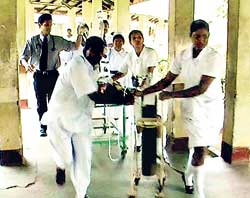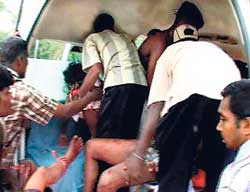
After the terror the battle for life beginsWhat emergency mechanisms are in operation to cope with terror attacks? Claymore mines rip apart three buses, one in Weli Oya, another in Madhu and the other in Buttala. A bomb on a bus in Dambulla. A suicide bomber triggers an explosion at the Fort Railway Station. Tears and trauma and amidst the carnage children, women and men, dead or injured.How does a shattered country cope? How hospitals cope Most hospitals cope as best they can and do in difficult circumstances the maximum within their capability. Just two kilometres from the scene of the incident, the Buttala District Hospital was able to give emergency treatment to around 60 victims with the resources available. Later 50 were transferred to the Moneragala Base Hospital 14 km away, said Buttala District Medical Officer Dr. Premalal Abeysooriya.
Added Moneragala's Acting Medical Superintendent Dr. D.C. Priyanath that they coped with the situation as the 390-bed base hospital, with 72 doctors, 250 nurses and four ambulances, was equipped and could cater to an emergency incident. "Most surgeries could also be performed here except specific operations such as dental and orthopaedic," he said, explaining that following the Buttala incident, ambulances were called in from nearby hospitals, medical teams were rushed from Colombo and Mahiyangana and those who required neurosurgical intervention transferred to the Colombo National Hospital. A few small issues with regard to equipment when dealing with a disaster have already been notified to the authorities, he said. The Dambulla Hospital is prepared to deal with an emergency and has the necessary resources, he said, adding that the moment they hear of an incident the emergency preparedness plan is activated with a ward being cleared for such casualties. "Different types of patients varying from critical to manageable are then treated on two different sides of the ward while patients with minor injuries are referred to the Outpatients Department (OPD)," said Dr. Arambegedara, stressing that the hospital doesn't function as a single unit but as a cluster. "So we get support from Kandy, Matale and Kurunegala Hospitals within minutes, be it staff or ambulances, if the need arises," he said. Dambulla Hospital was 90% successful in providing medical treatment in the recent incident, he says with justifiable pride. Among other facilities it has three ambulances and an equipped operating theatre. Although the hospital has only one surgeon, the MS does not see it as a problem because surgeons can be called in from nearby hospitals within 30 minutes while a patient is being stabilized and prepared for surgery. The unavailability of neuro and ENT surgeons is also not an acute problem, he said, adding that such patients can be transferred to Colombo via Kurunegala after two or three days.
"We also had the support of the Blood Bank which operates from Colombo as they sent us 75 pints of blood in addition to the stocks we had in the hospital's blood bank," he explained. Dr. Arambegedara said they have identified certain areas where they need assistance such as more emergency trolleys, patient trolleys and saline stands and alerted the health authorities. What of the ideal in an emergency situation? All accidents or incidents are categorized into three, explains Dr. Anil Jasinghe, the Director of the Accident Service of the National Hospital, with years of experience in facing different situations. It would be a small one if there is a solitary casualty, but any number between 5-10 would be classified as 'limited mass casualty' and more than that as a 'mass casualty incident', The Sunday Times learns. What is categorised as disaster If mass casualty incidents such as the one at the Fort Station are complicated with national ramifications it would be called a disaster like in the case of the Katunayake aiport incident, says Dr. Jasinghe, explaining that usually 'disasters' occur mostly in urban areas because the population density is high but there could be incidents like Kebithigollewa with a crowded bus being affected. In the event of such incidents the primary concern would be to rescue the casualties from the scene and take them to the nearest hospital. "In Sri Lanka this is carried out by civilians and they need to be commended for getting activated," he says, adding that the bulk of the casualties from the Fort blast was brought to hospital by trishaw, van or bus. Urging people living in rural areas to also inform the police and hospitals close to an incident site as soon as possible so that ambulances can be got to the scene, Dr. Jasinghe said some of the small rural hospitals may not have the capacity such as surgical facilities or the manpower to deal with such emergencies. "Usually, in advanced countries paramedics would carry out a 'casualty triage'," he said adding that in Sri Lanka small rural hospitals could be turned into triage hospitals and not definitive care institutions. First hour critical A casualty triage means sorting out the casualties into 'critical', 'moderate to severe' and 'walking', The Sunday Times learns. Normally, the walking casualties who are conscious and alert may be the ones demanding treatment and service even at the hospital. Therefore, it is important to identify the others who need immediate attention and stabilize them.
"This is of paramount importance to save lives," says Dr. Jasinghe, underlining the fact that the first-hour after an incident is crucial. The strategy should be for the rural cum triage hospital to then stabilize the critical casualties and transfer them to the major hospital nearest to it better geared to handle these casualties, while calling on that hospital and also provincial health authorities for support in the form of ambulances and personnel. Mobile units need of the hour Urging the development of a different angle, Dr. Jasinghe calls for the setting up of mobile units within communities to respond to emergency situations and help evacuate casualties. "They should be trained not only in evacuation but also rescue," he says, explaining that in Colombo there is the 110 service with five ambulances and a rescue vehicle equipped to cut through wrecks, while Dehiwela-Mount Lavinia, Hikkaduwa and Batticaloa have an ambulance service on a smaller scale. Tracing relatives of the victims The Disaster Management Centre of Sri Lanka comes in mostly to trace the relatives of casualties, after they are brought to hospital, explained its Director-General Gamini Hettiarachchi when contacted on their response to man-made disasters. Explaining the structure, Mr. Hettiarachchi said a large Emergency Response Committee gets activated in Colombo as soon as there is a crisis, while in each district there is a Coordinator and a few assistants to deal with such a situation who work closely with the relevant District Secretary. When asked specifically about an emergency such as a bomb blast, he said that usually people around such a place would be those who will take the injured to the nearest hospital. In nine districts around the country, a team from the security forces (army, navy or Air Force) has been seconded to assist the District Secretary along with the civilian Coordinators, The Sunday Times understands. Citing a few examples, Mr. Hettiarachchi said an Air Force team has been seconded to assist in Colombo, while in Amparai it is the Special Task Force, in Puttalam it is the army and in Gampaha it is the navy."They are part of the Emergency Response Units in each district," he added. In the wake of the tsunami many coastal villages have committees within them to alert the people about a disaster and also give first-aid, he said, stressing that these committees could also act as the eyes of the village in protecting it. Rapid Deployment Teams to the fore In a major proactive development, a Rapid Deployment Team consisting mainly of a surgeon and other support staff along with essential supplies such as blood will be airlifted to any rural hospital in case of an emergency, said Health Ministry Secretary Dr. Athula Kahandaliyanage. The rosters have been made up with names of surgeons drawn from the National, Colombo South, Sri Jayewardenepura and Ragama Hospitals, The Sunday Times learns. If and when the need arises the Rapid Deployment Team will be rushed by helicopter to the rural hospital needing the skills and expertise, with the help of the Air Force, Dr. Kahandaliyanage said. |
|
||||||
|| Front
Page | News | Editorial | Columns | Sports | Plus | Financial
Times | International | Mirror | TV
Times | Funday
Times || |
| |
Reproduction of articles permitted when used without any alterations to contents and the source. |
© Copyright
2008 | Wijeya
Newspapers Ltd.Colombo. Sri Lanka. All Rights Reserved. |


